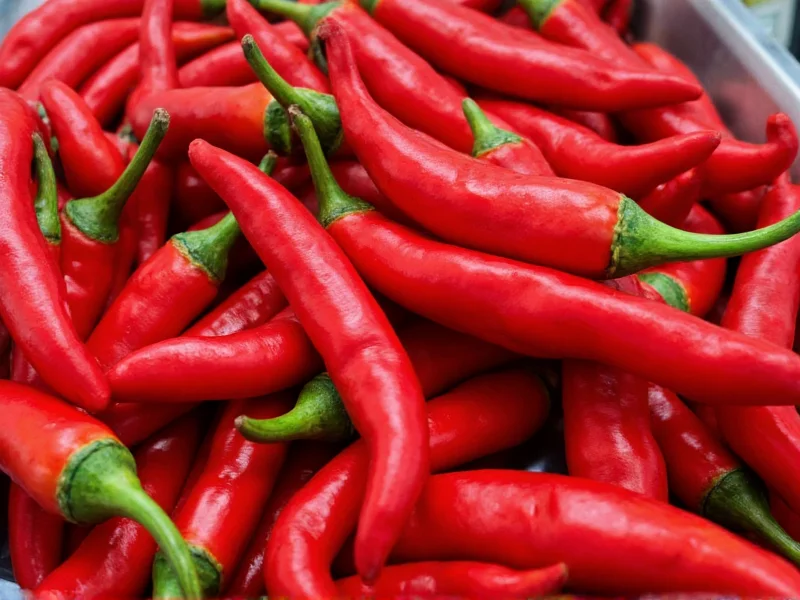Pasilla chiles, often called the “workhorse of Mexican cuisine,” deliver a nuanced heat experience that many home cooks misunderstand. These dried chilaca peppers (not to be confused with fresh poblanos, despite common misconceptions) provide culinary depth rather than intense fire. Understanding their precise heat level helps home chefs create balanced dishes that showcase authentic Mexican flavors without unintended spiciness.
What Exactly Are Pasilla Chiles?
The term “pasilla” translates to “little raisin” in Spanish, perfectly describing both their appearance and flavor profile. Fresh chilaca peppers transform into pasilla chiles through sun-drying, developing deep wrinkles and a dark brown to black color. Many grocery stores incorrectly label dried poblanos as “pasilla chiles,” causing confusion. True pasilla chiles come exclusively from dried chilacas, while dried poblanos are properly called ancho chiles.
Understanding Pasilla Chile Heat on the Scoville Scale
The Scoville scale measures capsaicin concentration, the compound responsible for chili heat. Pasilla chiles register between 1,000-2,500 Scoville Heat Units (SHU), placing them firmly in the mild to medium category. To put this in perspective:
| Chile Variety | Scoville Heat Units | Heat Comparison |
|---|---|---|
| Pasilla Chiles | 1,000-2,500 SHU | Mild to medium |
| Jalapeño | 2,500-8,000 SHU | 2-3 times hotter than pasilla |
| Ancho (dried poblano) | 1,000-2,000 SHU | Similar mild heat to pasilla |
| Habanero | 100,000-350,000 SHU | 40-140 times hotter than pasilla |
Unlike many hotter chiles that deliver immediate, sharp heat, pasilla chiles provide a gradual warmth that builds slowly, allowing their complex flavors to shine through. This characteristic makes them ideal for dishes where you want subtle heat rather than overwhelming spice.
Beyond Heat: The Flavor Profile of Pasilla Chiles
Pasilla chiles offer far more than just mild heat. Their flavor profile includes:
- Earthy, tobacco-like notes
- Subtle fruitiness reminiscent of dried berries
- Chocolate and coffee undertones
- Distinctive raisin-like sweetness
This complexity explains why pasilla chiles feature prominently in Mexican mole sauces, where their mild heat allows multiple ingredients to harmonize rather than compete. When properly rehydrated and blended, they create a smooth, rich base that enhances rather than dominates other flavors in a dish.
Culinary Applications for Pasilla Chiles
Chefs value pasilla chiles for their versatility across various cooking methods:
Sauces and Moles
As a foundational ingredient in many traditional moles, pasilla chiles provide depth without excessive heat. Their mild nature allows chocolate, spices, and other ingredients to shine through. For authentic mole negro, a blend of pasilla, mulato, and ancho chiles creates the signature complex flavor.
Stews and Braises
Adding whole or rehydrated pasilla chiles to braising liquids infuses dishes with subtle warmth and earthiness. Remove them before serving, similar to using bay leaves, for controlled flavor infusion without overwhelming heat.
Marinades and Rubs
Ground pasilla chile powder adds mild heat and complexity to meat rubs. Combined with cumin, garlic, and oregano, it creates balanced seasoning that enhances rather than masks the meat's natural flavor.
Common Substitutes for Pasilla Chiles
When pasilla chiles aren't available, consider these alternatives based on your heat tolerance and flavor needs:
- Ancho chiles: Nearly identical heat level (1,000-2,000 SHU) with slightly fruitier flavor
- Guajillo chiles: Slightly hotter (2,500-5,000 SHU) with brighter, tangier flavor
- Mulato chiles: Similar heat with stronger chocolate notes
- Combination approach: Mix ancho (for mild heat) with a small amount of chipotle (for smokiness) to approximate pasilla's complexity
When substituting, remember that dried chiles vary in potency based on growing conditions and age. Start with less than your recipe specifies, then adjust to taste after rehydrating and blending.
Handling Pasilla Chiles: Safety and Preparation Tips
Despite their mild heat rating, proper handling ensures the best results:
Rehydration Technique
For optimal flavor extraction, rehydrate pasilla chiles by:
- Removing stems and seeds (seeds contain most capsaicin)
- Soaking in hot water for 15-20 minutes until pliable
- Blending with soaking liquid for smooth sauces
Heat Management
Even mild chiles can cause discomfort if mishandled:
- Wear gloves when handling multiple chiles
- Avoid touching your face, especially eyes
- Wash hands thoroughly with soap after preparation
- If experiencing burning sensation, use dairy products (milk, yogurt) rather than water to neutralize capsaicin
Storage Recommendations
Dried pasilla chiles maintain quality for 6-12 months when stored properly:
- Keep in airtight container away from light and moisture
- Store in cool, dark pantry (not refrigerator)
- Freeze for long-term storage (up to 2 years)
- Check periodically for mold or musty odors indicating spoilage
Debunking Common Pasilla Chile Myths
Several misconceptions persist about these versatile chiles:
Myth: Pasilla and Ancho Chiles Are the Same
Reality: Anchos come from dried poblanos, while pasillas come from dried chilacas. Though similar in heat, they have distinct flavor profiles. This confusion stems from inconsistent labeling in American markets.
Myth: All Dried Mexican Chiles Are Extremely Hot
Reality: Many popular dried Mexican chiles, including pasilla, ancho, and mulato, fall in the mild to medium range. The misconception likely comes from association with hotter varieties like arbol or habanero.
Myth: Removing Seeds Eliminates All Heat
Reality: While seeds contain concentrated capsaicin, the white membranes attached to seeds hold most heat compounds. Proper deseeding requires removing both seeds and inner membranes for significantly milder results.











 浙公网安备
33010002000092号
浙公网安备
33010002000092号 浙B2-20120091-4
浙B2-20120091-4